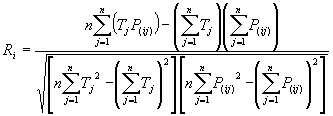| GeneXproTools 4.0 implements the R-square fitness function both with and without parsimony pressure. The
version with parsimony
pressure puts a little pressure on the size of the evolving
solutions, allowing the discovery of more compact models. The R-square fitness function of GeneXproTools 4.0 is, as expected, based on the standard R-square, which returns the square of the Pearson product moment correlation coefficient. The Pearson product moment correlation coefficient is a dimensionless index that ranges from -1 to 1 and reflects the extent of a linear relationship between the predicted values and the target values. The Pearson product moment correlation coefficient Ri of an individual program i is evaluated by the equation:
where P(ij) is the value predicted by the individual program
i for fitness case j (out of n fitness cases
or sample cases);
and Tj is the target value for fitness case j. fi = 1000*Ri*Ri and therefore ranges from 0 to 1000, with 1000 corresponding to the ideal.
where Si is the size of the program, Smax and Smin represent, respectively, maximum and minimum program sizes and are evaluated by the formulas: Smax = G (h + t) Smin = G where G is the number of genes, and h and t are the head and tail sizes (note that, for simplicity, the linking function was not taken into account). Thus, when rfi = rfmax and Si = Smin (highly improbable, though, as this can only happen for very simple functions as this means that all the sub-ETs are composed of just one node), fppi = fppmax, with fppmax evaluated by the formula:
|

